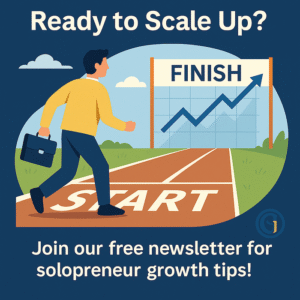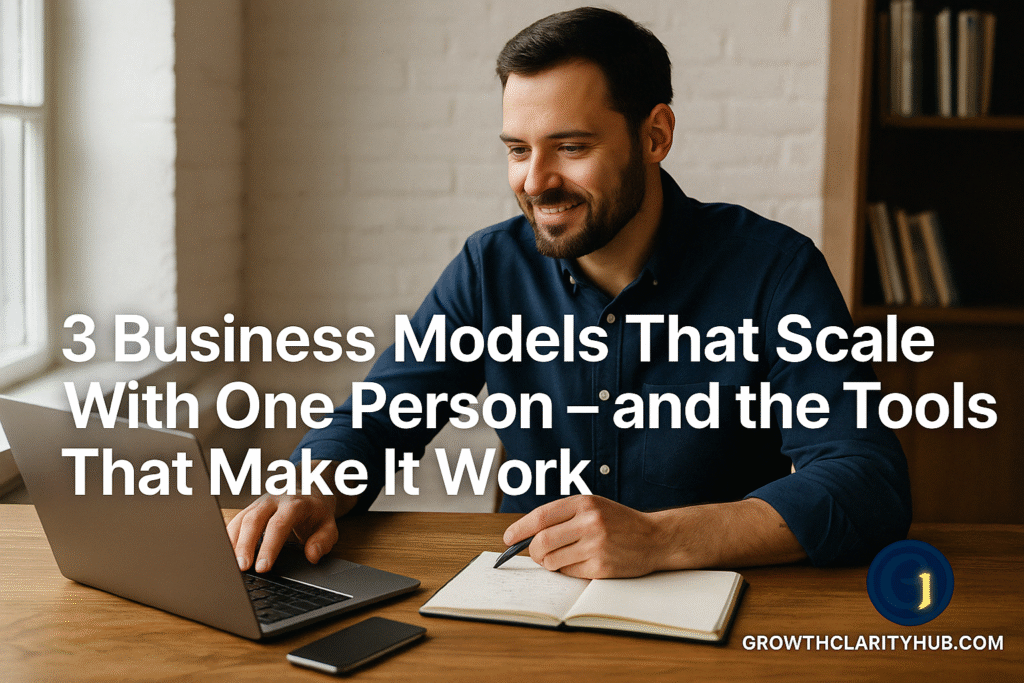Myth: You need a team to reach seven figures.
Truth: Over 100,000 entrepreneurs proved otherwise in 2022 by running million-dollar businesses solo (killerstartups.com).
Ever wonder how some solo entrepreneurs manage to grow their income without hiring a single employee? The secret is embracing scalable business models for solo entrepreneurs that let one person do the work of many. In fact, Forbes suggests that scaling as a solopreneur is entirely possible if you focus on business models that allow for automation, digital products, and recurring revenueforbes.com. Instead of burning out by doing more hours or feeling stuck with one-person capacity, you can design your business to scale efficiently. This article will introduce you to three proven one-person business models that can skyrocket your revenue without the need for a team. Along the way, we’ll share examples, tool stacks, and the logic that makes each model tick. By the end, you’ll have clarity on which one-person business ideas can become sustainable, solopreneur income streams for you.
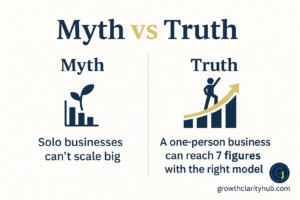
1. Productized Services: Turn Your Expertise into a Scalable Offering
Imagine taking a service you normally do custom (and repeatedly) and packaging it into a standardized, repeatable offer. That’s a productized service. Instead of reinventing the wheel for each client, you create a defined package with a clear scope, deliverables, and price. For example, a web designer might sell a “One-Week Website” package at a flat rate, or a copywriter could offer a monthly blog bundle (say, 4 posts per month for a set fee). Each client gets the same solution, delivered in a streamlined way.
Why it scales: Productized services let you serve more clients in less time because your process is consistent and efficient. You’re not starting from scratch for each project, so you save tons of time. Key benefits include:
-
Efficiency: No more writing proposals for every inquiry or tailoring your work from zero each time. You have a proven process that you run on autopilot.
-
Quality control: By focusing on one niche and outcome, you get better and faster at delivering results, which boosts your reputation and lets you charge more.
-
Delegation-ready: Once your service is well-documented, it’s easier to automate or outsource parts of it. (For more on deciding what to delegate or automate as a solopreneur, see our Build vs Buy vs Outsource guide – a handy framework for smart solo scaling.)
Example offerings:
-
A marketing consultant packages a “LinkedIn Makeover” service – optimizing a client’s profile and content strategy within 2 weeks, for a fixed $1,500.
-
An SEO specialist offers a “Local SEO Boost” bundle – one-time setup of local listings and on-site SEO fixes, at $800 per site.
Tool stack & tips: To make a productized service hum, set up tools that handle the repetitive parts. Use a scheduling app like Calendly for easy booking, template agreements/proposals to onboard clients, and a project management checklist for delivery. Automate what you can – for instance, automatically send a welcome email and questionnaire when someone signs up. Because you’ve systematized the service, you can even hand off tasks to a virtual assistant or software later without losing quality. The result? Your service becomes an assembly line that one person can manage, rather than a custom shop that requires constant hands-on effort.

2. Digital Products: Build Once, Sell Infinitely (Your Passive Income Engine)
This is the classic “make money while you sleep” model. Digital products allow you to create an asset one time and sell it to people all over the world, as many times as you want. For a solo entrepreneur, it’s one of the most powerful ways to stop trading time for money. Think e-books, online courses, video workshops, templates, toolkits, or even paid newsletters. These products encapsulate your knowledge or creativity in a format that can be purchased and delivered digitally – no physical inventory, no scheduling, no 1:1 client hours.
Why it scales: After the upfront investment of creating the product, each additional sale requires near-zero effort to fulfill. Whether 10 people or 10,000 people buy your course, you do roughly the same amount of work on delivery (thanks to automation). This means your income can grow without your workload growing alongside it. A few factors that make digital products a top-tier scalable model:
-
Decoupled from time: You create it once, and it can generate income for years. Sell an e-book for $30 – the first sale might cover your coffee, but sell 1,000 copies and that’s $30,000 with no extra writing from you.
-
Automated delivery: Platforms like Gumroad, Shopify, or Teachable handle payment and file delivery/membership access. You could be on vacation while your system sells and delivers your course to a new customer.
-
High margins: No shipping or manufacturing costs, and after covering your initial creation and platform fees, the rest is largely profit.
That said, digital products aren’t an automatic goldmine. The internet is littered with courses no one bought. The two ingredients you absolutely need are (1) an audience and (2) a product that solves a real, painful problem for that audience. Without an interested audience, you’ll hear crickets on launch day. Without a useful solution, even the best marketing won’t create repeat buyers. In other words, build something people genuinely want, and build an audience that trusts you, before expecting significant sales.
Example scenarios: A fitness coach could film a 30-day workout video program and sell it as an on-demand course. A seasoned freelancer might compile their knowledge into a “Freelancer Success Toolkit” (including proposal templates, budgeting sheets, etc.) as a downloadable bundle. These become new solopreneur income streams that keep paying off long after the work is done.
Tool stack & tips: Start by identifying a topic or skill you’re constantly teaching or a question you’re always answering – that’s prime content for a digital product. Choose a delivery format you’re comfortable with (writing, video, design templates, etc.). Use creation tools (for example, Notion or Google Docs for an e-book draft, Loom or Zoom for recording video lessons, Canva for designing templates). Then pick a platform to host or sell: course platforms like Teachable or Podia for rich multimedia courses, or e-commerce platforms like Gumroad or Shopify for simpler downloads. Email marketing is crucial here – services like Mailchimp or ConvertKit help you build a list of potential buyers and keep them engaged with newsletters or launch updates. Don’t forget to gather feedback from early buyers; you can refine the product or create new ones based on what your audience wants next.
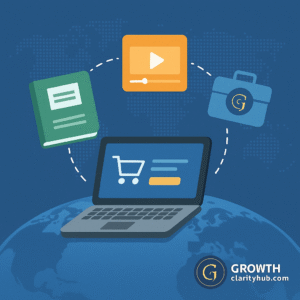
3. Audience-Funded Coaching/Consulting: Let Content Fuel Your Service Growth
What if you could have marketing that runs itself and consistently brings you high-paying clients? That’s essentially what audience-funded coaching or consulting achieves. In this model, you give away valuable content for free (via blogging, YouTube, podcasts, social media threads, newsletters, etc.) to build an audience. As your audience’s trust in you grows, a portion will naturally seek more help – and that’s where you offer paid services like one-on-one coaching, consulting packages, or group coaching programs. Your free content acts as a funnel that funds your paid coaching, hence “audience-funded.”
Why it scales: You might wonder, “Isn’t coaching still trading time for money?” It is, but the scaling power lies in your content and how you structure your services:
-
One-to-many marketing: Creating a helpful video or article can reach thousands of people without any additional effort from you once it’s published. That’s infinitely more scalable than one-to-one sales calls. Your content works 24/7, attracting prospects and warming them up to your ideas, even while you sleep.
-
High-ticket conversions: By the time someone from your audience is ready to pay, they often already trust you (thanks to your content). This means you can charge premium rates for your coaching or consulting. You don’t need hundreds of clients – a handful of well-paying clients can match a full-time income.
-
Group offerings: As demand increases, a solo coach can switch from purely one-on-one sessions to group coaching or workshops. For example, instead of 8 individual one-hour sessions a week, you host a weekly group call for 8 clients at once – delivering value to many in the same hour. That’s scaling your impact and freeing time.
In practice, this model might look like: A career consultant posts insightful LinkedIn articles every week. Her posts reach thousands, establishing her as an expert (for free). Out of those readers, a steady trickle contacts her for paid one-on-one coaching. Over time, she launches a group coaching program for job seekers at a higher price point, leveraging the demand she’s built. All of this happened without hiring a marketing team or spending on ads – her content did the heavy lifting.
Tool stack & tips: The cornerstone here is a content platform where you consistently show up. It could be a blog on your website, a YouTube channel, a Twitter (X) account, a Substack newsletter – wherever your target audience hangs out. Use social media scheduling tools (Buffer, Hootsuite) or newsletter services to maintain regular output with minimal manual effort. Engage with your audience by responding to comments and emails – this builds relationship and trust. For the coaching side, you’ll want a reliable video meeting setup (Zoom, Google Meet) and a way to manage appointments (Calendly can auto-handle your scheduling). Perhaps create a private community for clients (a Slack group or Discord server for your paying members) to add value without a huge time cost. Treat your content creation like a system: repurpose one piece of content into many formats (e.g., turn a podcast episode into a blog post or a Twitter thread) to maximize reach. The key mindset shift is to see your content not just as free help, but as the top of a funnel guiding those who need more into your paid offerings. Every piece of content should have a purpose, whether it’s building credibility or gently nudging readers toward a call-to-action (like booking a free discovery call or signing up for a webinar).
Pro tip: Consistency is everything. Set a realistic content schedule and stick to it. Over time, as your audience grows, listen to their questions – they will literally tell you what services or products to offer next. Many successful one-person business owners start by consulting, then notice common issues and turn those into a course or book. In this way, audience-funded services can evolve into digital products too, giving you the best of both worlds.
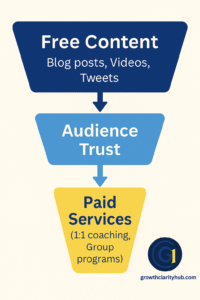
Quick Recap: 3 One-Person Business Models that Scale
These three scalable models prove that a one-person business can punch above its weight class:
-
Productized Services – Standardize a service so you can deliver consistently and efficiently. Easier to automate and delegate, allowing you to serve more clients without working more hours.
-
Digital Products – Create an asset once (book, course, etc.) and sell it repeatedly. A largely passive income stream for solopreneurs, but requires an audience and real value to succeed.
-
Audience-Funded Coaching – Use content as your marketing engine. Build trust at scale through free content, then offer premium consulting or coaching to those who want deeper help. Your expertise + audience = a self-sustaining client pipeline.
Each of these models can generate significant income for a solo entrepreneur, without hiring a team. The best part? You can mix and match them over time (for instance, many start with a service, then add a digital product once they see what their audience needs, effectively combining models).
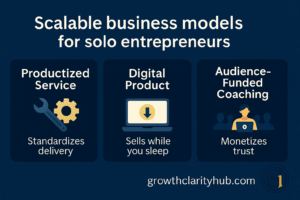
Conclusion: Choose Your Path and Scale Smart
You don’t need a staff of 50 or venture capital funding to achieve big results. As a solo entrepreneur, you have the advantage of agility and low overhead – you can experiment and implement these models quickly. The key is to pick the model that aligns best with your skills and business type and then go all in on making it work. If you love working directly with clients and delivering a service, a productized service or coaching model might fit like a glove. If you prefer creating and selling products while you sleep, then focus on a digital product strategy. Whichever path you choose, commit to it and systematize the heck out of it.
Remember: Scaling isn’t about doing everything yourself; it’s about doing the right things in a repeatable way. Leverage technology, automation, and even occasional outsourcing for support (as we discussed in Build vs Buy vs Outsource). Keep your operations lean and your processes tight. When you find something that works, double down and let it run. When you need to free up time, find a tool or helper to take over the mundane parts. This way, growth won’t equate to personal burnout.
Finally, stay patient and consistent. None of these models are “get rich quick” schemes – they are sustainable paths that compound over time. The first product sale or the first 1,000 followers are the hardest, but if you keep at it, the tenth sale or the 10,000th follower will come much faster. By building a scalable foundation, you set yourself up for exponential growth down the line.
Ready to take the next step? Don’t just read about these ideas—pick one model and take action this week. Outline that service package, draft that e-book, or publish that introductory blog post. You’ll be amazed how one small action can start a chain reaction for your one-person business. And if you want more guidance on growing your solo venture sustainably, be sure to join our newsletter for weekly tips, case studies, and resources tailored for solo entrepreneurs. Your scalable success story starts now!
